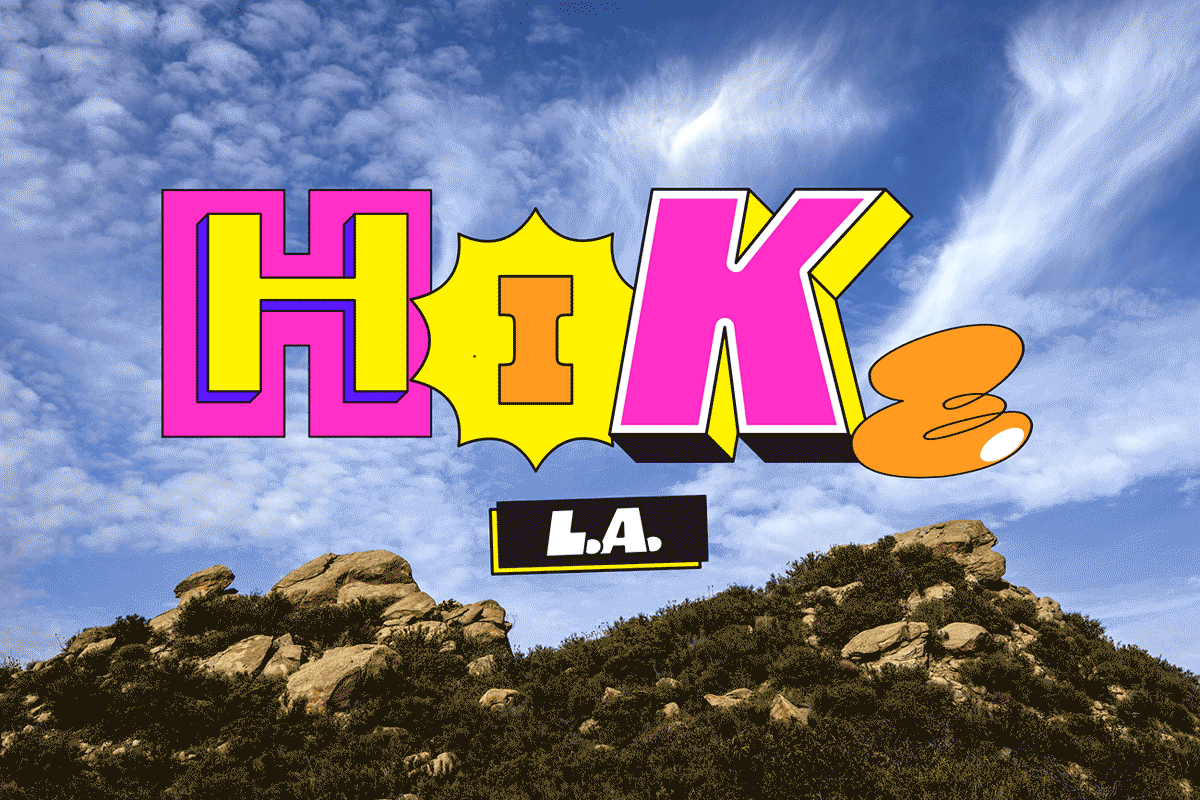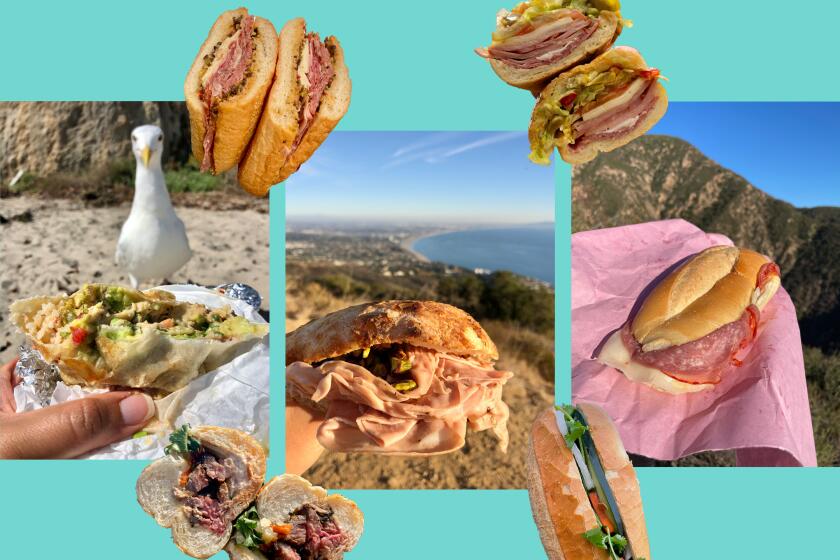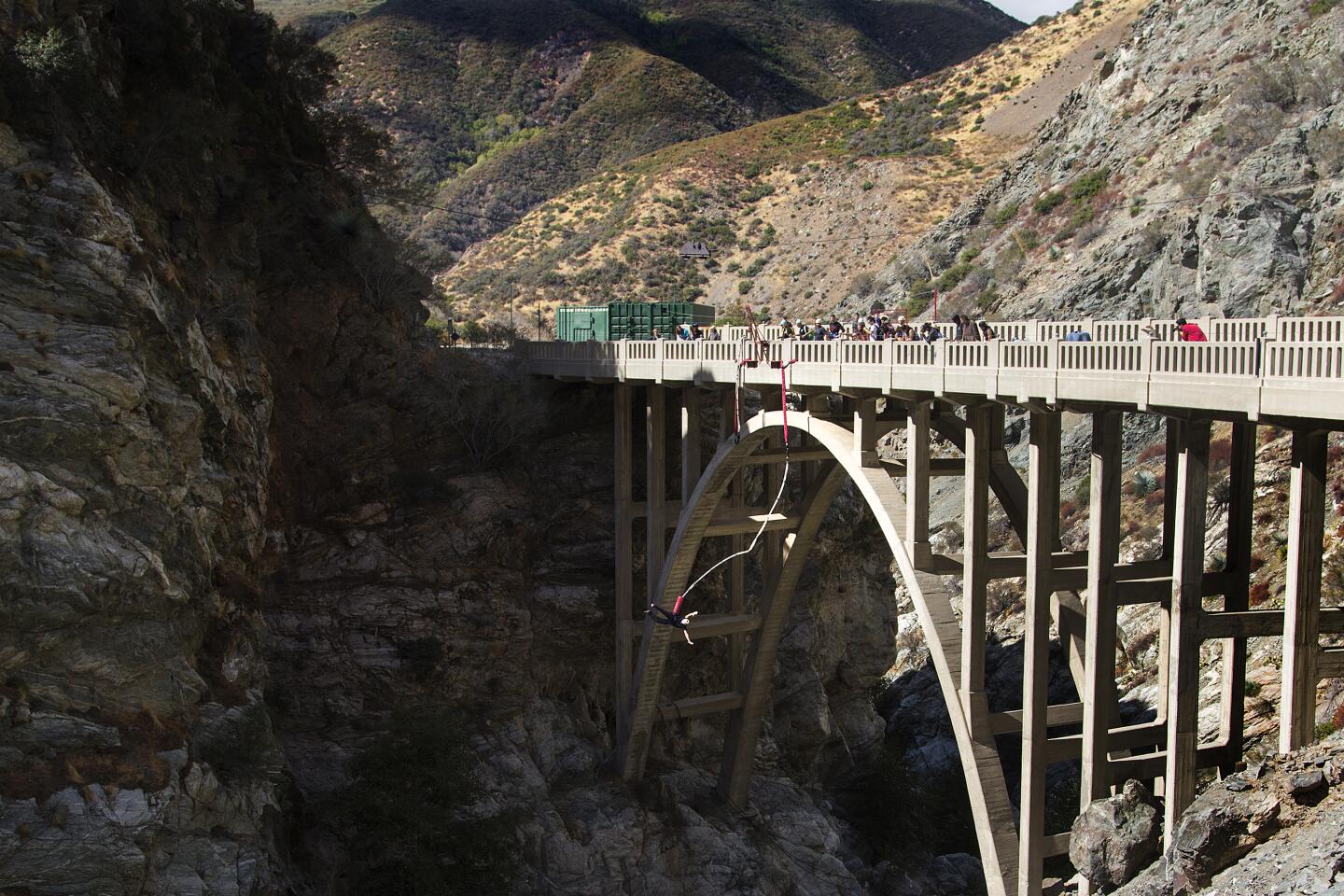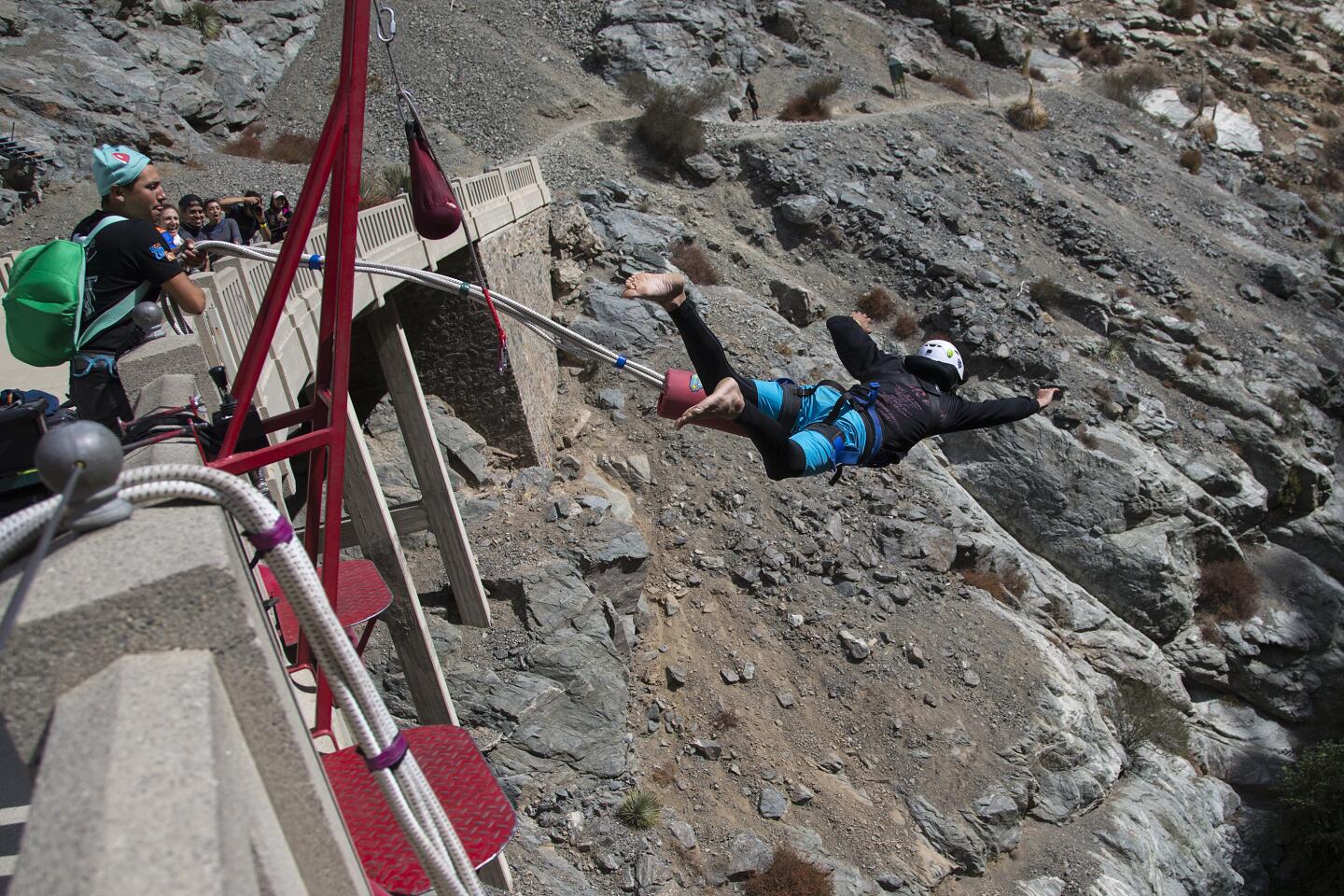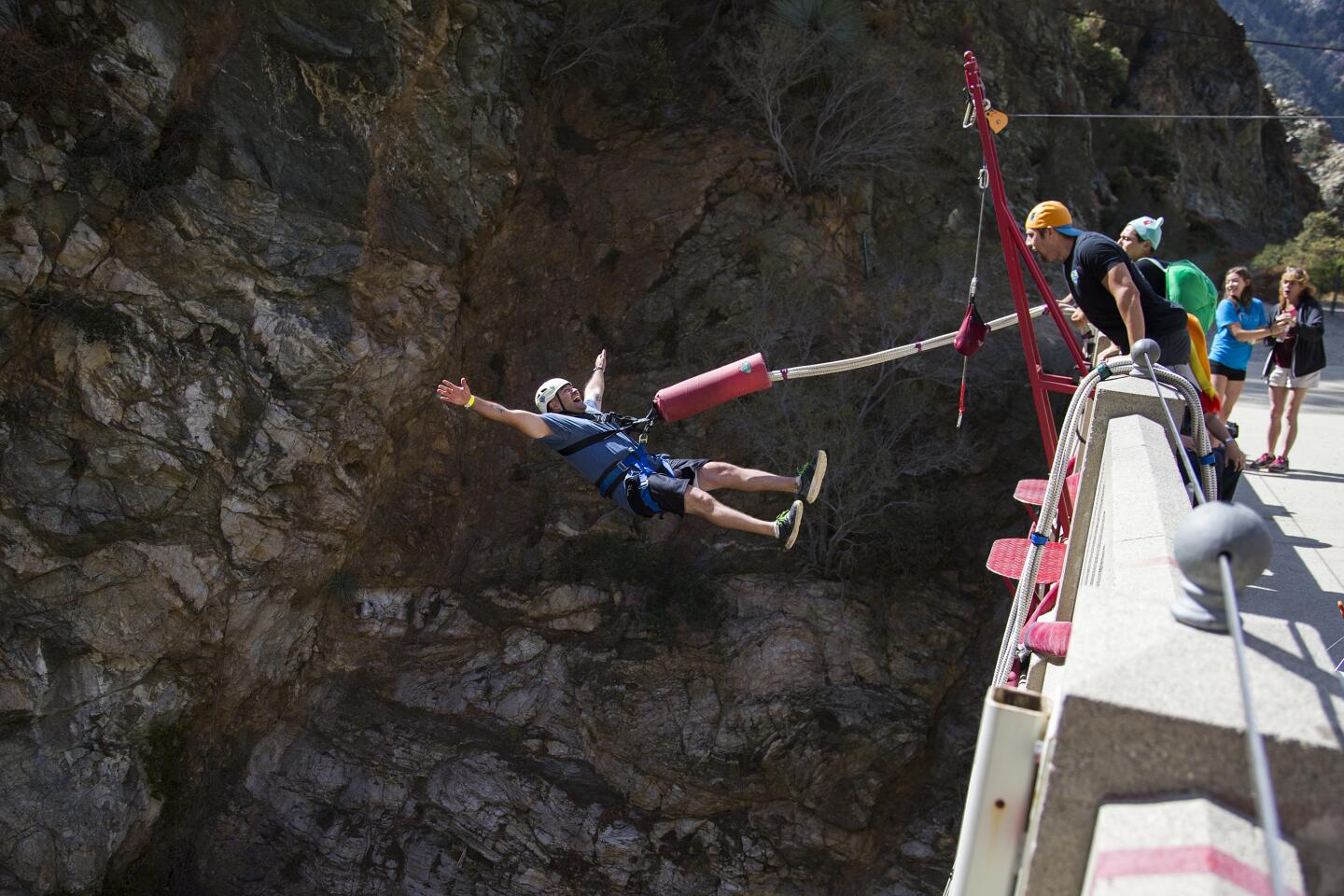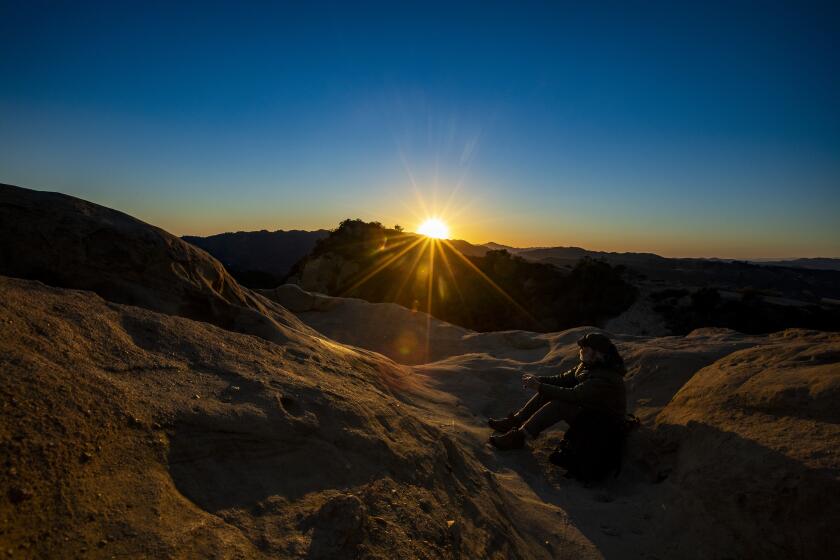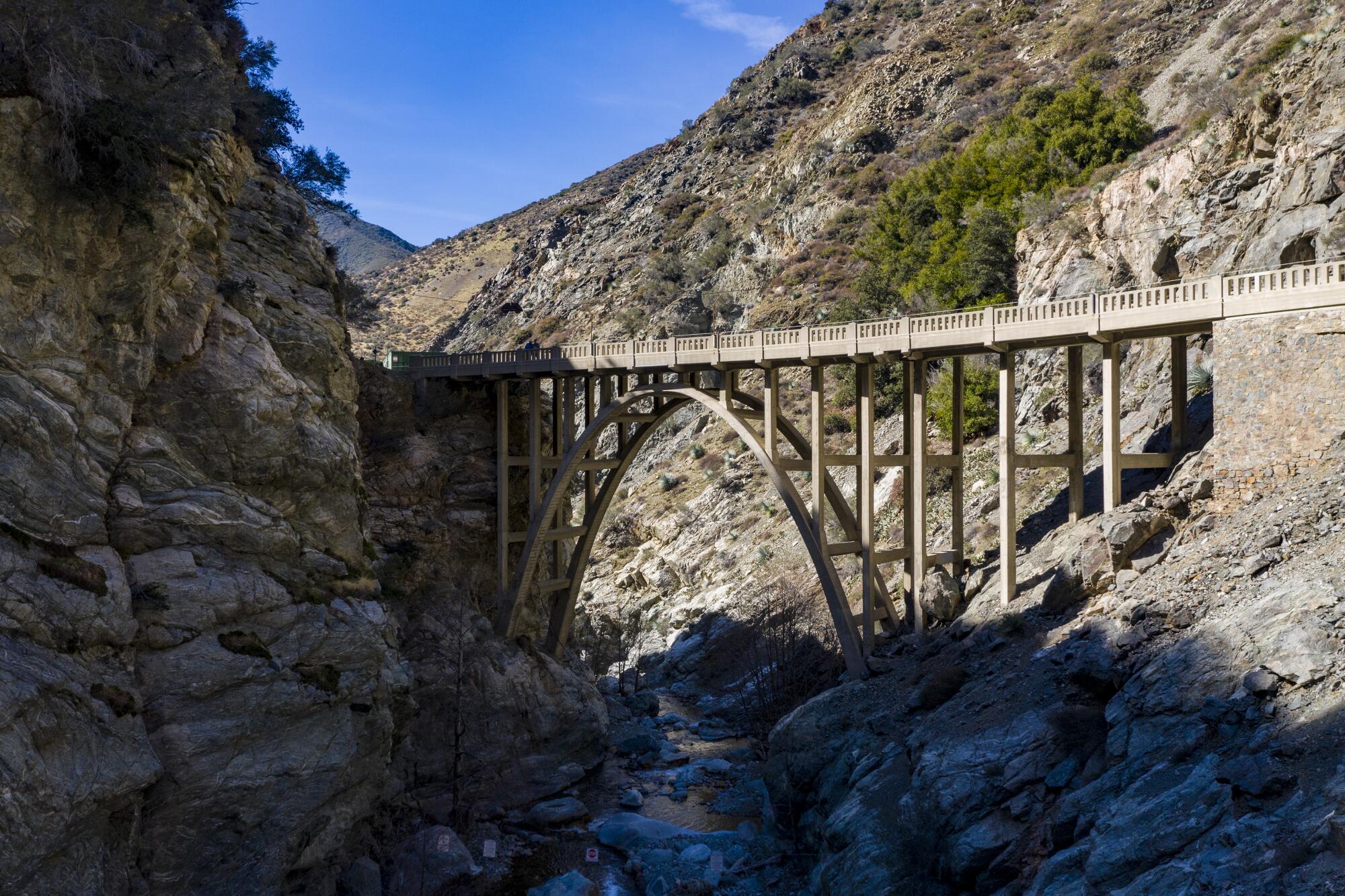
- Share via
This story is part of our ultimate guide to hiking in L.A. You can buy a print copy at the L.A. Times store.
Deep in the folds of the San Gabriel Mountains, five miles from the nearest paved road, stands the Bridge to Nowhere.
It’s sturdy enough to have lasted 85 years, strange enough to draw crowds and start arguments. Especially lately.
To reach it, park at the end of Camp Bonita Road near LaVerne and start walking along the East Fork of the San Gabriel River, with steep slopes rising on either side.

On the East Fork Trail, you’ll gain about 800 feet of elevation, ford the river several times, tiptoe amid loose rock and sidle past enough Spanish bayonet cactus (a.k.a. chaparral yucca) to pop every balloon in the American West.
Whether you’re looking for ocean views or desert landscapes or soaring mountain peaks, Los Angeles offers miles upon miles of strikingly different trails.
But first, you will have questions. How did this extraneous infrastructure get here? Who owns it? Why hike to it?
Those answers are coming, but they make more sense once you’re standing in the canyon. That’s why, on a sunny morning in February, Times photographer Brian van der Brug and I hit the trail for the 10-mile round-trip journey.
I knew the two-lane concrete bridge was built in 1936 as part of a plan for a quicker route from the San Gabriel Valley to Wrightwood on the east side of the mountains. So far, so good. But in 1938, a flood changed the plan.
Even though the bridge was done and blacktop had been laid along the roadway-to-be, the builders walked away, leaving their folly on a 50-acre plot surrounded now by the Angeles National Forest and Sheep Mountain Wilderness.
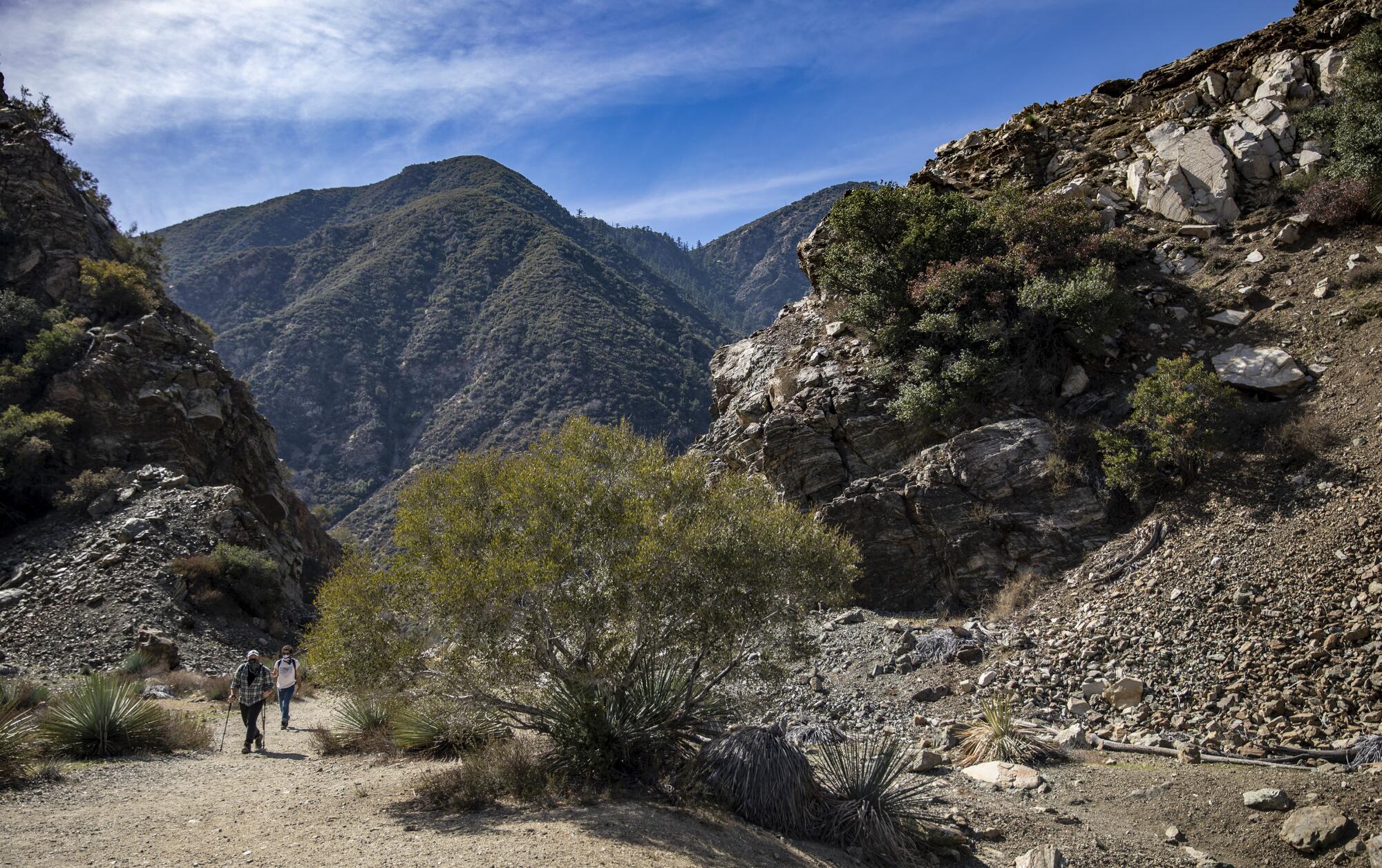
At 9 a.m., we set off for that folly, the river burbling to our left. It’s a mostly flat path but with plenty of rock-hopping. And as the trail wriggles, you have no choice but to cross the river. At least six times.
For us, the water never reached knee level. But you do need to watch your step and check the weather first.
Even in light rain, the river swells, often for days. That fast, cold water makes crossings risky, and several fatalities have been reported along the river’s East Fork in recent years.
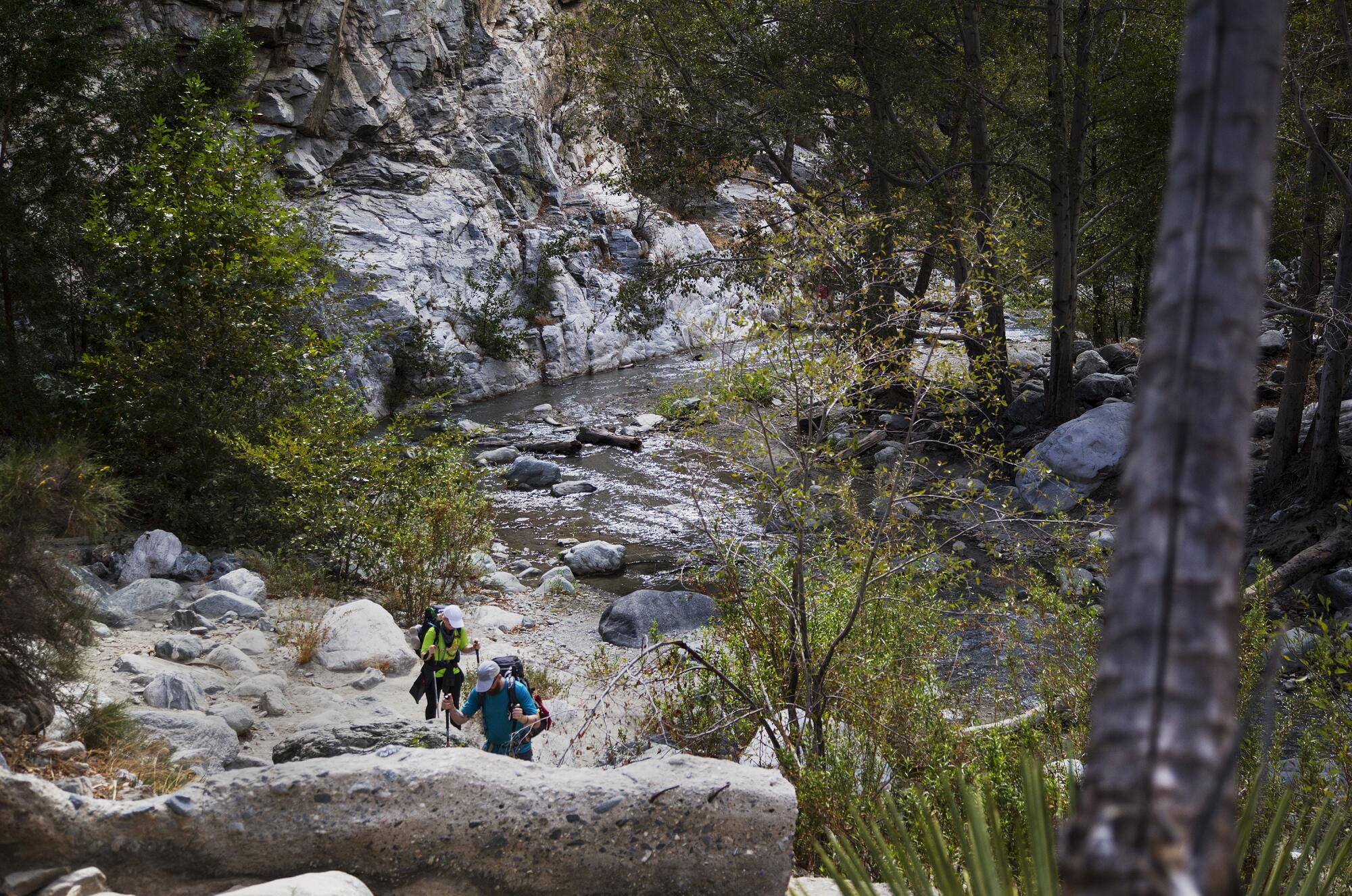
We made sure to hike on a weekday, when parking is easier than on weekends. On Saturdays and Sundays, other hikers told us, the trailhead lot fills fast and latecomers must park along the shoulder of the road.
A hike is a good excuse to eat a sandwich. A sandwich improves every hike, and in L.A., you can almost always find one not far from the other.
Why so much activity? Here’s where the story takes another turn.
In 1989, an outdoorsy entrepreneur and chiropractor named Ron Jones bought the 50 acres that includes the bridge. He soon had government approvals to establish a weekend business staging bungee jumps from the bridge.
More than 162,000 jumps later, Bungee America continues. Prices begin at $99 per jump, and Jones is quick to point out there’s never been a fatality.
He doesn’t have to allow hikers on his property, he said, but he does. Because of the canyon’s shape, you can’t see the bridge without stepping onto his land.
“It’s an amazing hike,” said Jones, who estimates he’s done it 2,000 times. “We see bighorn sheep up there almost every weekend.”
His advice to hikers? “Use common sense. There are lots of rocks. You don’t have to worry about rattlesnakes this time of year, but in summer that’s something to be aware of.”
As for all those river crossings: “We do the entire hike in wet shoes.”
Lately, there are a lot more hikers on the trail. The surge began early in the pandemic, during that spell of severity when county officials closed beaches and many other recreational options. A wave of new adventure seekers rolled into the San Gabriels, along with litter and graffiti.
“I have seen more litter, more graffiti and more vandalism in that canyon than in any other time in the past 32 years,” Jones said. “The pandemic has changed the landscape.”
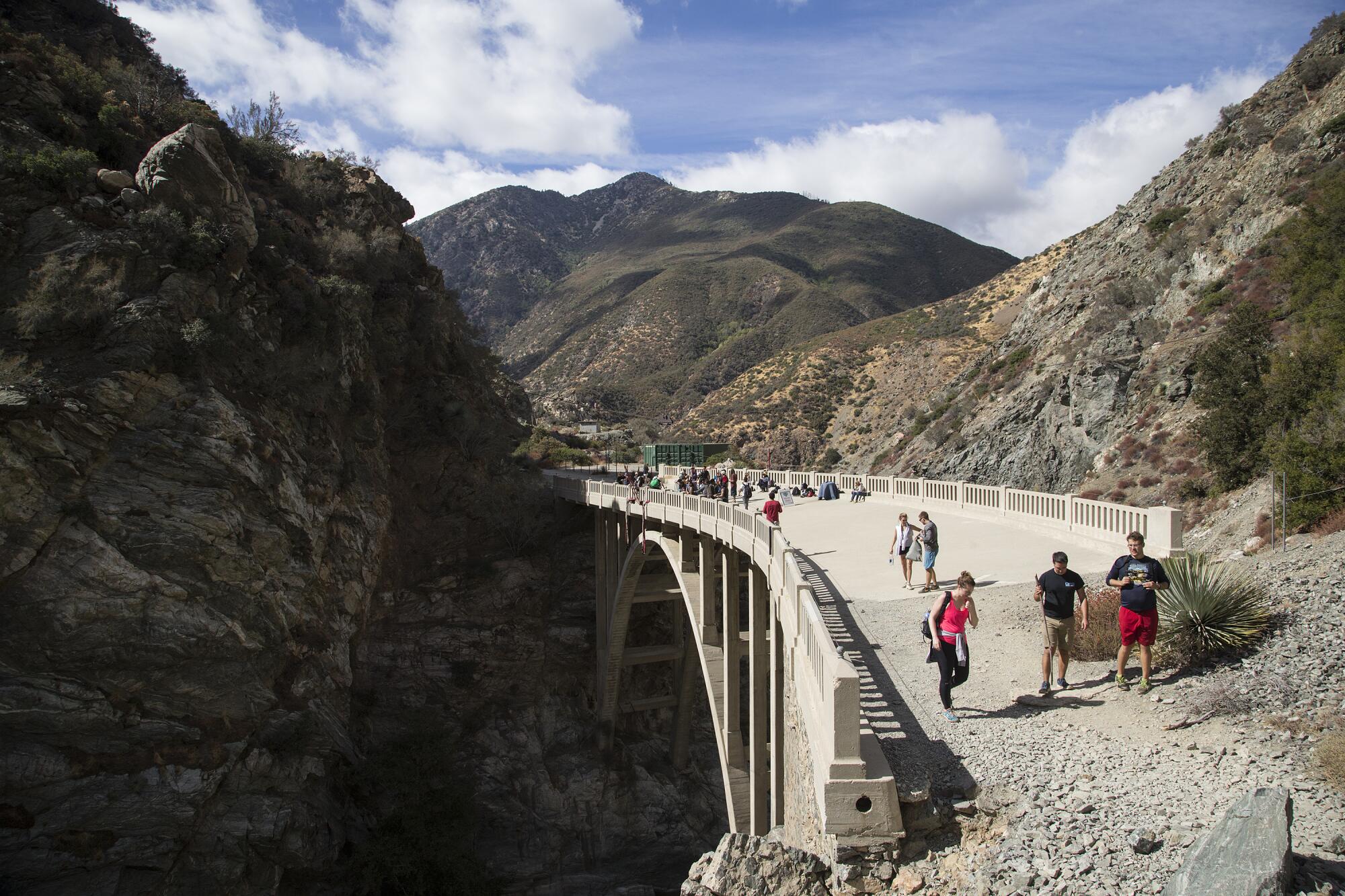
Angeles National Forest public information officer John Clearwater said workers haul more than 10 tons of trash a week from the San Gabriel Canyon area, which includes many other trails. He had no specific figures for the East Fork Trail, except to say, “It is very heavily used.”
The litter, which seemed to dwindle after the first mile or two, didn’t bother me as much as the graffiti did. Just as you begin to feel as if you’ve left behind the city, another spray-paint scrawl turns up on a rock, tree or old bit of riverside infrastructure. Somebody thought it would be helpful to mark the trail with bursts of yellow and red.
For years, Jones said, he has instructed his employees to pick up litter along the path to the bridge. But now there’s too much, he said, and he’s thinking about charging a user fee that hikers must pay to step onto his property. This would be something like the Forest Service’s Adventure Pass ($5 a day, $30 a year), which is required if you’re hiking the East Fork Trail.
Jones would use that money, he said, to hire staff to clean up the trail even though most of it belongs to the Angeles National Forest.
From footwear to sun hats and socks to sun-proof shirts, these are some fresh styles for five hiking must-haves.
“We are in conversation with Ron Jones and are looking at the impacts on our forest visitors,” Clearwater said.
In other words, this hike might get pricier. And tidier.
The farther we hiked, the less paint and litter we saw. And because we were following a river up a canyon, there was no chance of getting lost. Instead of worrying about that, we pondered the best spots to cross the water, kept an eye out for bighorn sheep (no luck) and came up with new questions.
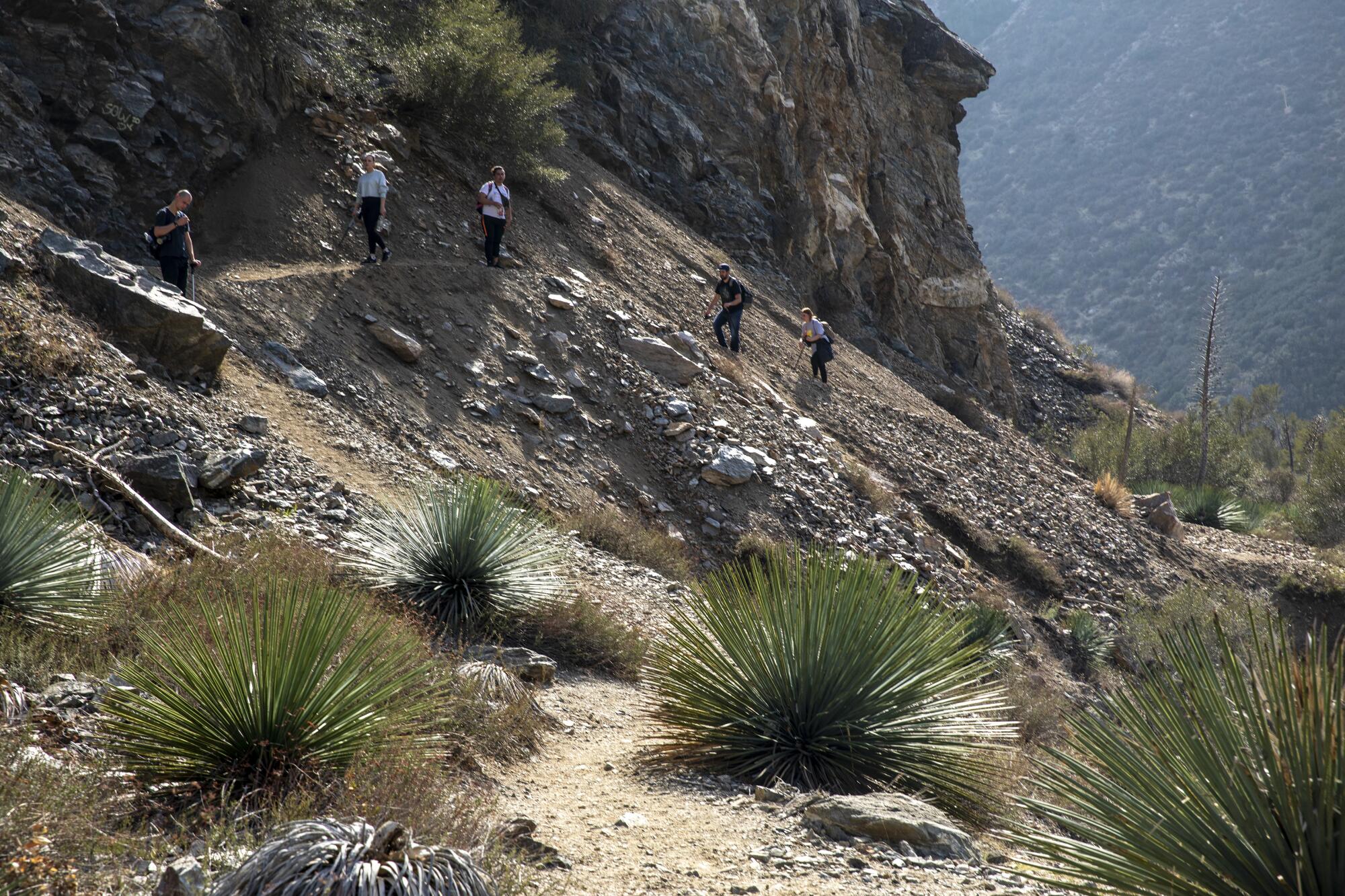
Why are these mountains so steep?
About a third of John McPhee’s 1989 book “The Control of Nature” is devoted to that question.
“The San Gabriels, in their state of tectonic youth, are rising as rapidly as any range on earth,” McPhee wrote. “Their loose inimical slopes flout the tolerance of the angle of repose. Rising straight up out of the megalopolis, they stand ten thousand feet above the nearby sea, and they are not kidding with this city. Shedding, spalling, self-destructing, they are disintegrating at a rate that is also among the fastest in the world.”
OK, so how bad was that flood in 1938?
It’s the reason the Los Angeles River is imprisoned today in miles of concrete channel.
That rain-fed flood killed scores of people (estimates vary) along the Los Angeles and Santa Ana rivers, destroyed 5,600 homes and inundated highways, bridges and railroad tracks throughout L.A. County.
Along the Los Angeles River, local leaders asked the Army Corps of Engineers to make neighboring areas safer, and the engineers came up with the concrete channel.
The San Gabriel River, already controlled by multiple dams, did less damage in that flood. But as you stand in the shallows on the East Fork, well above those dams, it’s terrifying to imagine a 50-year surge coming your way.
That guy hunched by the riverside — is he panning for gold or fiddling with fishing gear?
Could be either.
After our first water crossing, we met Mark Flo of Lakewood and his friend Dave Robinson of Seal Beach, both in full fly-fishing gear. They’d been on the water for two hours.
Like many other anglers here in recent years, they’d caught nothing.
“The river has suffered these last few years,” said Flo, who has hiked and fished the San Gabriel since 1990. “This used to be full of rainbow trout. But between the gold mining and the drought ....”
Best way to complete the trail through the Santa Monica Mountains from Malibu to Pacific Palisades
Said Robinson: “It’s a great little ecosystem. It’s been damaged over the years. But it’ll come back. We just need to get out of the way.”
At several points, we passed men with prospecting tools. It’s illegal to prospect along the East Fork (panning, sluicing or dredging) but it’s also common. Asked how many prospecting citations had been issued along the East Fork in the last two years, officials said they “don’t have information on citations at this time.”
Some prospectors bring tents and all sorts of tools. Others sit by the water with a pan.
A man from Torrance pointed out a tiny gleaming fleck in his muddy pan.
“I surfed for 50 years. But now I can’t get to my feet fast enough. So I do this,” he said. Then his eyes twinkled — more brilliantly, I have to say, than his little fleck.
“Fifteen thousand of these,” he said, “and I’ve got 100 bucks.”
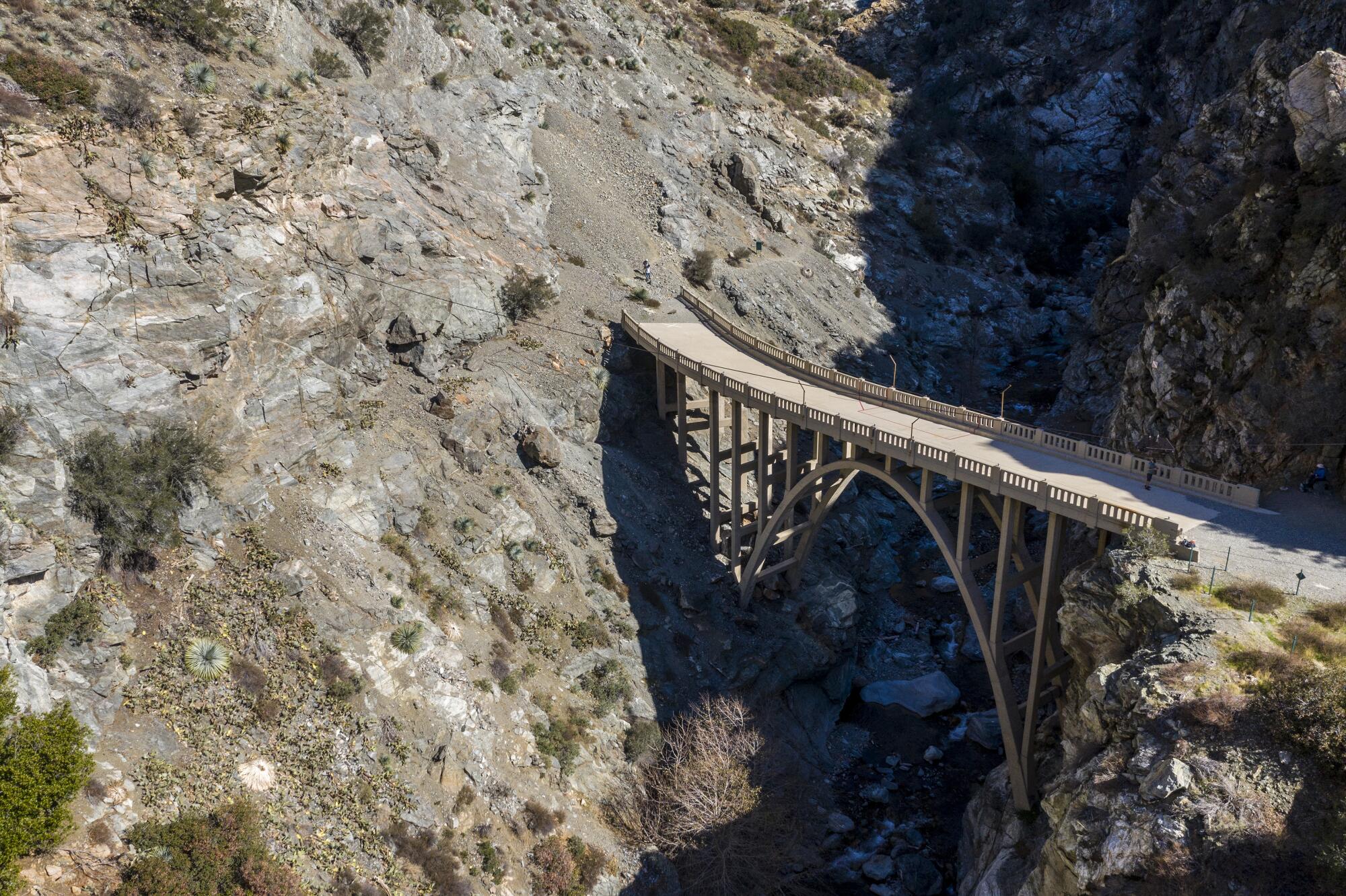
We reached the bridge after 3½ hours of hiking — though if you’re not stopping to conduct interviews and take pictures, as we did, you might get there faster. Bungee jumpers make this same trek; no shortcuts. Because the trail climbs a few hundred feet above the river in its last mile, you’re even with the top of the bridge when you first glimpse it.
You notice the completion date, “1936,” etched at one end, the two lanes leading to solid canyon wall on the other side. The deadest of ends.
When we showed up, the site was deserted, which was perfect. For a better angle, we crossed the span (about 100 feet) and continued a few steps up the canyon. That gave us the big picture: the entire manmade spectacle rising 120 feet from a chasm full of river-washed granite boulders. No graffiti.
Another two or three hikers would show up every 10 or 15 minutes.
“It’s beautiful. The rocks are amazing,” said Daniela Osorio, a Caltech geology grad student, gazing at the black-and-white patterns on the chasm wall.
Meanwhile I looked at the bridge again. Why was it so familiar?
From Malibu to La Jolla, here are five Southern California trails that do something most hikes don’t — take you to the edge of the ocean.
Like Pasadena’s storied Colorado Street Bridge (completed in 1913 and 150 feet high), this concrete span has an open-spandrel design that draws your eye to its arch and supports. The two could be cousins.
And then I pictured Big Sur’s Bixby Creek Bridge, about 360 miles northwest. Also concrete, also with an open-spandrel design, 280 feet high, built in 1932. A big sister.
The return half of the hike was much quicker, a little more than two hours. On the way, I thought again about McPhee, who wrote, “In Los Angeles versus the San Gabriel Mountains, it is not always clear which side is losing.”
True that. But if you can get to the Bridge to Nowhere and back again, unharmed and uncrowded, leaving only footprints and carrying a renewed recognition of the puniness of mankind and the might of the San Gabriels, you’re absolutely winning.
If you go
The East Fork Trailhead, which leads to the Bridge to Nowhere, is at the terminus of Camp Bonita Road in La Verne. The parking lot includes restrooms. The Forest Service requires hikers to have an Adventure Pass ($5 per day or $30 per year, available from many convenience stores, gas stations and government outlets near trailheads).
